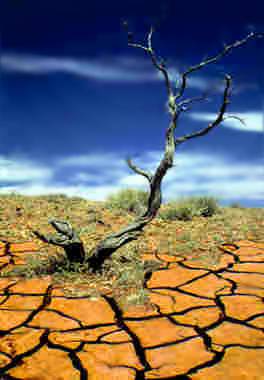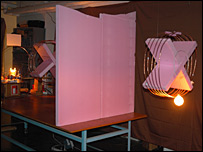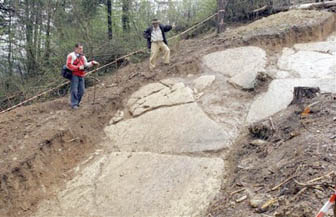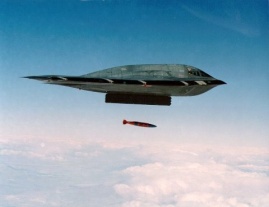|
 In Association With
Mysteries
Magazine!
In Association With
Mysteries
Magazine!
6/15/07 #421
http://www.conspiracyjournal.com
Subscribe for free at our subscription page:
http://www.members.tripod.com/uforeview/subscribe.html
You can view this newsletter online at:
https://uforeview.tripod.com/conspiracyjournal421.html
Pay no attention to that man
behind
the curtain – he may be trying to control your mind with microwave
beams. Or he could be hiding the truth about aliens and
UFOs. Or he could be selling drugs to finance some government
priority that the public need not know about. Or he could be
reading the latest issue of the number one, weekly conspiracy
newsletter of strange stuff and high weirdness - Conspiracy Journal!
This
week Conspiracy Journal brings
you such thought-provoking stories as:
-
U.S. Experiencing Drought for
the Ages -
-
Public Donates to Fund
Backward-in-Time Research -
- Wireless Energy Promise Powers Up
-
-
Bosnian
Pyramid of the Sun
Loses Funding -
AND: Pentagon Confirms It Sought
To Build A 'Gay Bomb'
All these exciting stories and MORE
in this week's issue of
CONSPIRACY JOURNAL!
~ And Now, On With The Show! ~

DOCTORS
SAY IT IS ALL IN THEIR HEADS - BUT THOSE
INFLICTED KNOW THE HORRIFYING TRUTH!
It Feels Like
Bugs are Crawling Under Your Skin!

MORGELLONS:
LEVEL FIVE PLAGUE
OF THE NEW WORLD ORDER
THIS IS THE
FIRST BOOK PUBLISHED THAT ADDRESSES THE MYSTERIOUS DISEASE THAT IS
RAMPAGING ACROSS THE GLOBE!
It has struck all across the
globe with horrifying symptoms that seem to be ripped straight from the
pages of a horror novel. Its victims all complain of the same symptoms,
yet doctors brush them off as being in their head.
It is called Morgellons, and it seems to have appeared out of
nowhere and is rapidly spreading with a speed and ferocity that
has left its victims shocked and helpless. Sufferers first notice a
strange feeling as if bugs are crawling and biting just under their
skin. More terrifying are the weird sores that sprout thread-like
fibers that almost seem to be alive!
Read first-hand reports from those unlucky enough to have caught
Morgellons and are left helpless, ignored, and worse yet, labeled with
the stigma of mental illness to explain away their sickness.
Nevertheless, Morgellons is all too real, only the true causes and
origins of this disease remain shrouded in mystery.
In this must have book, Commander X takes a close look at some of the
leading theories on the origins of Morgellons. Is it a natural disease
that has been with us all along? Is it a man-made disease that has
somehow escaped from a lab? Is it biological warfare, or a terrorist
attack? Is it an extraterrestrial pathogen that has managed to root
itself upon planet Earth after traveling inconceivable distances from
outer space?
This Frightening
Book by Commander X is now available for the
incredible price of only $20.00
BUT WAIT, THERE'S MORE!
For only $45.00 you
can get both the
book and
Dr. Len Horowitz's DVD (or VHS) EMERGING VIRUSES: AIDS,
EBOLA AND VACCINATIONS (125
minutes).
So don't delay, order your copy of MORGELLONS:
LEVEL FIVE PLAGUE OF THE NEW WORLD ORDER today for only $20.00 plus
$5.00 for shipping - Or $45.00
plus $5.00
shipping for both the book and video -
A GREAT PRICE!
You can also phone in your
credit card orders to Global Communications
24-hour hotline: 732-602-3407
And as always you can send a
check or money order to:
Global Communications
P.O. Box 753
New Brunswick, NJ 08903
NOW ON
SALE!
MYSTERIES MAGAZINE #17

In This Fantastic Issue:
The Hidden History of Haitian Vodou By K. Filan
Oak Island Money Pit:
The Dig Just Keeps Getting Deeper
An Interview with Ray Santilli
The Signs of Stigmata
George Hensley's Serpent Handlers
PLUS: Summer Horoscopes
AND MORE!
Get your issue TODAY at your favorite bookstore
or magazine stand.
- TWENTY-FIRST CENTURY DUST BOWL
DEPARTMENT -
U.S. Experiencing Drought for the Ages

Drought, a fixture
in much of the West for nearly a decade, now covers more than one-third
of the continental USA. And it's spreading.
As summer starts, half the nation is either
abnormally dry or in outright drought from prolonged lack of rain that
could lead to water shortages, according to the U.S. Drought Monitor, a
weekly index of conditions. Welcome rainfall last weekend from Tropical
Storm Barry brought short-term relief to parts of the fire-scorched
Southeast. But up to 50 inches of rain is needed to end the drought
there, and this is the driest spring in the Southeast since
record-keeping began in 1895, according to the National Climatic Data
Center.
California and Nevada just recorded their driest
June-to-May period since 1924, and a lack of rain in the West could
make this an especially risky summer for wildfires.
Coast to coast, the drought's effects are as varied
as the landscapes:
.In central California, ranchers are selling cattle
or trucking them out of state as grazing grass dries up. In Southern
California's Antelope Valley, rainfall at just 15% of normal erased the
spring bloom of California poppies.
.In South Florida, Lake Okeechobee, America's
second-largest body of fresh water, fell last week to a record low - an
average 8.89feet above sea level. So much lake bed is dry that 12,000
acres of it caught fire last month. Saltwater intrusion threatens to
contaminate municipal wells for Atlantic coastal towns as fresh
groundwater levels drop.
.In Alabama, shallow ponds on commercial catfish
farms are dwindling, and more than half the corn and wheat crops are in
poor condition.
Dry episodes have become so persistent in the West
that some scientists and water managers say drought is the "new normal"
there. Reinforcing that notion are global-warming projections warning
of more and deeper dry spells in the Southwest, although a report in
last week's Science magazine challenges the climate models and suggests
there will be more rainfall worldwide later this century.
"It seems extremely likely that drought will become
more the norm" for the West, says Kathy Jacobs of the Arizona Water
Institute, a research partnership of the state's three universities.
"Droughts will continue to come and go, but . higher temperatures are
going to produce more water stress." That's because warmer temperatures
in the Southwest boosts demands for water and cause more to evaporate
from lakes and reservoirs.
"The only good news about drought is it forces us to
pay attention to water management," says Peter Gleick of the Pacific
Institute, a think tank in Oakland that stresses efficient water use.
This drought has been particularly harsh in three
regions: the Southwest, the Southeast and northern Minnesota.
Severe dryness across California and Arizona has
spread into 11 other Western states. On the Colorado River, the water
supply for 30 million people in seven states and Mexico, the Lake
Powell and Lake Mead reservoirs are only half full and unlikely to
recover for years. In Los Angeles County, on track for a record dry
year with 21% of normal rain downtown since last summer, fire officials
are threatening to cancel Fourth of July fireworks if conditions
worsen. On Wednesday, Los Angeles Mayor Antonio Villaraigosa urged
residents to voluntarily cut water use 10%, the city's first such call
since the 1990s.
In Minnesota, which is in its worst drought since
1976, the situation is improving slowly, although a wildfire last month
burned dozens of houses and 115 square miles in the northeastern part
of the state.
The Southeast, unaccustomed to prolonged dry spells,
may be suffering the most. In eight states from Mississippi to the
Carolinas and down through Florida, lakes are shrinking, crops are
withering, well levels are falling and there are new limits on water
use. "We need 40-50 inches of rainfall to get out of the drought," says
Carol Ann Wehle of the South Florida Water Management District.
Despite a recent storm, water hasn't flowed in
Florida's Kissimmee River, which feeds Lake Okeechobee, in 212 days.
The district has imposed its strictest water-use limits ever in 13
counties, cutting home watering to once a week and commercial use by
45%.
The drought also has provided an occasional benefit:
Okeechobee's record low level allowed crews to clean out decades of
muck and debris.
And some stricken areas are recovering. Texas and
Oklahoma, charred by wildfires in the dry winter of 2005-06, are
drought-free.
Even in California, where winter snowpack in the
Sierra Nevada range was only 27% of normal this year, plentiful runoff
from last year's snows filled many reservoirs, so shortages are
unlikely this year. But another dry winter would tax supplies.
Gleick says water managers are not reacting
forcefully enough to the drought: "The time to tell people that we're
in the middle of a drought and to institute strong conservation
programs is today, not a year from now." The Metropolitan Water
District of Southern California is doing that. Last month, it began a
"Let's Save" radio campaign.
After nearly a decade of drought in parts of the
West, the nation's fastest-growing region wrestles with rising water
demands and declining supply.
Donald Wilhite of the National Drought Mitigation
Center says the Southwest and Southeast are "becoming gradually more
vulnerable to drought" because the rising population will need more
water. "We think of water as an unlimited resource," he says. "But what
happens when you turn on the tap and it's not there?"
Source: WBIR
http://www.wbir.com/printfullstory.aspx?storyid=46077
-
GONNA GO BACK IN TIME DEPARTMENT -
Public Donates to Fund
Backward-in-Time Research

Experiment may be 'weird,' but donors think it's pretty cool.
It can take a village to save science -- a village that so far includes
a Las Vegas music mogul, Kirkland rocket scientist, Port Townsend
artist, Bothell chemist, Louisiana gas-and-oil man with a place in Port
Angeles and a Savannah, Ga., computer programmer.
The public has stepped forward with cash to boldly go where nobody in
the mainstream scientific establishment wants to go -- or, at least, to
have to pay for the attempt to go.
John Cramer, a physicist at the University of Washington, is reflected
among some of the materials he's using for an experiment that
challenges the traditional concept of time. The public has donated
$35,000 to his research.
Backward. In time, that is.
A University of Washington scientist who could not obtain funding from
traditional research agencies to test his idea that light particles act
in reverse time has received more than $35,000 from folks nationwide
who didn't want to see this admittedly far-fetched idea go unexplored.
"This country puts a lot more money into things that seem to me much
crazier than this," said Mitch Rudman, a music industry executive in
Las Vegas whose family foundation donated $20,000 to the experiment.
"It's outrageous to me that talented scientists have to go looking for
a few bucks to do anything slightly outside the box."
What John Cramer is proposing to do is certainly outside the box. It's
about quantum retrocausality.
"He's looking into the fundamental qualities of the universe," said
Denny Gmur, a scientist who works for a biotechnology firm in Bothell.
"I had $2,000 set aside to buy myself a really nice guitar, but I
thought, you know, I'd rather support something that's really
mind-boggling and cool."
Almost everything in quantum theory is mind-boggling and outside the
box, sometimes transforming the box into an inverted spherical cube of
infinite volume or forcing an entirely new definition of the essence of
boxness.
Cramer, a physicist, for decades has been interested in resolving a
fundamental paradox of quantum mechanics, the theory that accounts for
the behavior of matter and energy at subatomic levels. It's called the
Einstein-Podolsky-Rosen paradox.
It was set up by Albert Einstein (and two other guys named Rosen and
Podolsky) in the 1930s to try to prove the absurdity of quantum theory.
Einstein didn't like quantum theory, especially one aspect of it he
ridiculed as "spooky action at a distance" because it seemed to require
subatomic particles interacting faster than the speed of light.
However, experimental evidence has continued to pile up demonstrating
the spooky action. Two subatomic particles split from a single particle
do somehow instantaneously communicate no matter how far apart they get
in space and time. The phenomenon is described as "entanglement" and
"non-local communication."
For example, one high-energy photon split by a prism into two
lower-energy photons could travel into space and separate by many light
years. If one of the photons is somehow forced up, the other photon --
even if impossibly distant -- will instantly tilt down to compensate
and balance out both trajectories.
As the evidence for this has accumulated, several fairly contorted and
unsatisfying efforts have been aimed at solving the puzzle. Cramer has
proposed an explanation that doesn't violate the speed of light but
does kind of mess with the traditional concept of time.
"It could involve signaling, or communication, in reverse time," he
said. Physicists John Wheeler and Richard Feynman years ago promoted
this idea of "retrocausality" as worth considering. Cramer's version
aimed at using retrocausality to resolve the EPR paradox is dubbed (by
him) the "transactional interpretation of quantum mechanics."
Most physicists, such as the celebrated cosmologist Stephen Hawking,
still believe time can move only in one direction -- forward. Cramer
contends there is no hard and fast reason why.
He has proposed a relatively simple bench-top experiment using lasers,
prisms, splitters, fiber-optic cables and other gizmos to first see if
he can detect "non-local" signaling between entangled photons. He hopes
to get it going in July. If this succeeds, he hopes to get support from
"traditional funding sources" to really scale up and test for photons
communicating in reverse time.
It may be important to note, at this point, that Cramer is not crazy.
On Sunday, he began his annual stint running particle physics
experiments at the Brookhaven National Laboratory's Relativistic Heavy
Ion Collider. He and others at the national lab use the supercollider
to smash together particles, create the hottest matter ever made by
humans and study things such as quarks or other subatomic particles.
Cramer, who also writes science fiction books as a hobby, earlier
worked at CERN, the world's largest particle physics laboratory, on the
border between France and Switzerland. In the 1980s, he was director of
the UW's nuclear physics laboratory and today remains a well-respected
experimental physicist.
"I'm not crazy," he confirmed. "I don't know if this experiment will
work, but I can't see why it won't. People are skeptical about this,
but I think we can learn something, even if it fails."
Not too long ago, Cramer thought he would not even be allowed to fail.
None of the standard scientific funding agencies wanted any part of the
project. NASA's Institute for Advanced Concepts sent Cramer a rejection
letter, adding it was getting out of the advanced concepts business
anyway -- now that most of the space agency's money is going to the
federal government's renewed push into manned spaceflight.
The most creative branch of the military-science-industrial complex
(known as DARPA, Defense Advanced Research Projects Agency) also
rejected Cramer's proposal. Officials at DARPA told the UW physicist
his experiment is "too weird" -- even though they recently gave money
in support of a project aimed at creating Terminatorlike liquid robots.
"I thought we were going to have to pull the plug," Cramer said. But
when word of his funding plight went out across the Internet a few
months ago after a Seattle P-I article, people like Rudman and Gmur
began contacting the UW to see if they could lend some support.
"Heck, if it works we can go back in time and get our money back,"
laughed John Crow, a businessman who splits his time between his
gas-and-oil business in Shreveport and a home in Port Angeles.
Crow donated $3,000 because he found Cramer's approach too fascinating
not to try.
"I'm just a crass businessman, but in business we know high risk offers
high reward," he said. "This isn't that much money to find out if time
can go both forward and backward."
Walter Kistler, a retired physicist and rocket scientist who started
Redmond-based Kistler Aerospace, donated $5,000. Kistler's company
struggled for many years unsuccessfully promoting the concept of
reusable rockets, even going bankrupt once, but recently won a NASA
contract.
"I know how difficult it can be to get people to even consider new or
unusual ideas," he said. "Even Einstein had trouble accepting the basic
ideas of quantum theory. I've talked to professor Cramer, and what he
is trying to do could be very important."
Kistler said he was overjoyed to hear that other people thought this
was worth supporting.
"Artists have experienced non-local space all along, we just can't
prove it," said Richard Miller, an artist and photographer in Port
Townsend. Miller, who prefers not to disclose the amount of his
donation, said he's not worried about the strong possibility of failure
here.
"I would say the predicted failure of this project is probably a good
omen," he said. "Most predictions are wrong."
Cramer said it's possible that the primary goal of his experiment could
fail and yet still produce something of value. Some new subtlety about
the nature of entanglement could be revealed, he said, even if the
photons don't engage in measurable non-local communication. The
"disentanglement" itself, he said, could be quite revealing.
"It wouldn't be as nice as a positive result, but it would certainly be
interesting and publishable," Cramer said. If there is an interesting
negative result or a half-positive result, he said he will buy more
precise equipment to see if he can tease out what's happening. Cramer
has all the money he needs for this phase, but he hopes to see a second
phase.
In the music business, said Rudman, the Las Vegas music mogul, most
records they produce don't do well. In the vernacular, he said, "They
stiff."
"But the rare hits we get every once in a while pay for all the stiffs,
and then some," Rudman said. "If this stiffs, it stiffs. But, man,
you've got to try, don't you? You've got to be willing to take the risk
of being wrong to find something new."
HOW TO DONATE
The University of Washington has set up a special account to which
individuals or groups can contribute funds for John Cramer's experiment.
Tax-deductible contributions to the project may be made by contacting
Jennifer Raines, UW Department of Physics, at
jraines@phys.washington.edu, or mailing a check made out to the
University of Washington with a notation on the check directing deposit
to the account for "Non-Local Quantum Communication Experiment" to:
Jennifer Raines, Administrator
Department of Physics
University of Washington
Box 351560
Seattle, WA 98195-1560
Source: Seattle PI
http://seattlepi.nwsource.com/local/319367_timeguy12.html
-
TINKER-TOY SPECIES DEPARTMENT -
Designer Bug Holds Key to Endless
Fuel

The U.S. scientist who cracked the human genome is poised to create the
world's first man-made species, a synthetic microbe that could lead to
an endless supply of biofuel.
Craig Venter has applied for a patent at more than 100 national offices
to make a bacterium from laboratory-made DNA.
It is part of an effort to create designer bugs to manufacture hydrogen
and biofuels, as well as absorb carbon dioxide and other harmful
greenhouse gases.
DNA contains the instructions to make the proteins that build and run
an organism.
The J. Craig Venter Institute in Rockville, Maryland, is applying for
worldwide patents on what it refers to as Mycoplasma laboratorium based
on DNA assembled by scientists. When asked whether the world's first
synthetic bug was thriving in a test tube, Dr Venter said: "We are
getting close."
The Venter Institute's US Patent application claims exclusive ownership
of a set of essential genes and a synthetic "free-living organism that
can grow and replicate" that is made using those genes. To create the
synthetic organism his team is making snippets of DNA, known as
oligonucleotides or "oligos", of up to 100 letters of DNA.
To build a primitive bug, with about 500 genes in half a million
letters of DNA, Dr Venter's team is stitching together blocks of 50 or
so letters, then growing them in the gut bug E. coli. Then they turn
these many small pieces into a handful of bigger ones until eventually
two pieces can be assembled into the circular genome of the new life
form.
The synthetic DNA will be added to a test tube of bacteria and the team
hopes that one or more microbes starts moving, metabolising and
multiplying.
The Canadian ETC Group, which tracks developments in biotechnology,
believes that this development is more significant than the cloning of
Dolly the sheep a decade ago.
On Wednesday, ETC spokesman Jim Thomas called on the world's patent
offices to reject the applications. He said: "These monopoly claims
signal the start of a high-stakes commercial race to synthesise and
privatise synthetic life forms. Will Venter's company become the
'Microbesoft' of synthetic biology?"
A colleague, Pat Mooney, said: "For the first time, God has
competition. Venter and his colleagues have breached a societal
boundary, and the public hasn't even had a chance to debate the
far-reaching social, ethical and environmental implications of
synthetic life."
However, Dr Venter did ask a panel of experts to examine the
implications of creating synthetic life. His institute convened a
bioethics committee to see if its plans were likely to raise objections.
The committee had no objections but pointed out that scientists must
take responsibility for any impact their new organisms had if they got
out of the lab. The organisms can be designed to die as soon as they
leave laboratory conditions.
Dr Venter announced the project to build a synthetic life form in 2002.
In theory, by adding functionalised synthetic DNA, the bacterium could
be instructed to produce plastics, drugs or fuels.
Dr Venter's institute claims that its stripped-down microbe could be
the key to cheap energy production. The patent application claims an
organism that can make either hydrogen or ethanol for industrial fuels.
Source: The Age
http://www.theage.com.au/news/world/designer-bug-holds-key-to-endless-fuel
/2007/06/09/1181089398547.html
-
TESLA WAS RIGHT DEPARTMENT -
Wireless Energy Promise Powers Up

A clean-cut vision of a future freed from the rat's nest of cables
needed to power today's electronic gadgets has come one step closer to
reality.
US researchers have successfully tested an experimental system to
deliver power to devices without the need for wires.
The setup, reported in the journal Science, made a 60W light bulb glow
from a distance of 2m (7ft).
WiTricity, as it is called, exploits simple physics and could be
adapted to charge other devices such as laptops.
"There is nothing in this that would have prevented them inventing this
10 or even 20 years ago," commented Professor Sir John Pendry of
Imperial College London who has seen the experiments.
"But I think there is an issue of time. In the last few years we have
seen an exponential growth of mobile devices that need power. The power
cable is the last wire to be cut in a wireless connection."
Professor Moti Segev of the Israel Institute of Technology described
the work as "truly pioneering".
The researchers from the Massachusetts Institute of Technology (MIT)
who carried out the work outlined a similar theoretical setup in 2006,
but this is the first time that it has been shown to work.
"We had a strong faith in our theory but experiments are the ultimate
test," said team member Assistant Professor Marin Soljacic.
"So we went ahead and sure enough we were successful, the experiments
behave very much like the theory."
The experimental setup consisted of two 60cm (2ft) diameter copper
coils, a transmitter attached to a power source and a receiver placed
2m (7ft) away and attached to a light bulb.
With the power switched on at the transmitter, the bulb would light up
despite there being no physical connection between the two.
Measurements showed that the setup could transfer energy with 40%
efficiency across the gap.
The bulb was even made to glow when obstructions such as wood, metal
and electronic devices were placed between the two coils.
"These results are encouraging. The numbers are not far from where you
would want for this to be useful," said Professor Soljacic.
The system exploits "resonance", a phenomenon that causes an object to
vibrate when energy of a certain frequency is applied.
When two objects have the same resonance they exchange energy strongly
without having an effect on other surrounding objects. There are many
examples of resonance.
"If you fill a room with hundreds of identical glasses and you fill
each one with a different level of wine each one will have a different
acoustic resonance," explained Professor Soljacic.
Each glass would ring with a different tone if knocked with a spoon,
for example.
"Then if I enter the room and start singing really loudly one of the
glasses may explode if I hit exactly the right tone."
Instead of using acoustic resonance, WiTricity exploits the resonance
of low frequency electromagnetic waves.
In the experiment both coils were made to resonate at 10Mhz, allowing
them to couple and for "tails" of energy to flow between them.
"With each cycle arriving, more pressure, or voltage in electrical
terms, builds up in this coil," explained Professor Pendry.
Over a number of cycles the voltage gathered until there was enough
pressure, or energy, at the surface to flow into the light bulb. This
accumulation of energy explains why a wine glass does not smash
immediately when a singer hits the right tone.
"The wine glass is gathering energy until it has enough power to break
that glass," said Professor Pendry.
Using low frequency electromagnetic waves, which are about 30m (100ft)
long, also has a safety advantage according to Professor Pendry.
"Ordinarily if you have a transmitter operating like a mobile phone at
2GHz - a much shorter wavelength - then it radiates a mixture of
magnetic and electric fields," he said.
This is a characteristic of what is known as the "far field", the field
seen more than one wavelength from the device. At a distance of less
than one wavelength the field is almost entirely magnetic.
"The body really responds strongly to electric fields, which is why you
can cook a chicken in a microwave," said Sir John.
"But it doesn't respond to magnetic fields. As far as we know the body
has almost zero response to magnetic fields in terms of the amount of
power it absorbs."
As a result, the system should not present any significant health risk
to humans, said Professor Soljacic.
The team from MIT is not the first group to suggest wireless energy
transfer.
Nineteenth-century physicist and engineer Nikola Tesla experimented
with long-range wireless energy transfer, but his most ambitious
attempt - the 29m high aerial known as Wardenclyffe Tower, in New York
- failed when he ran out of money.
Others have worked on highly directional mechanisms of energy transfer
such as lasers. However, unlike the MIT work, these require an
uninterrupted line of sight, and are therefore not good for powering
objects around the home.
Professor Soljacic and his team are now looking at refining their setup.
"This was a rudimentary system that proves energy transfer is possible.
You wouldn't use it to power your laptop.
"The goal now is to shrink the size of these things, go over larger
distances and improve the efficiencies," said Professor Soljacic.
The work was done in collaboration with his colleagues Andre Kurs,
Aristeidis Karalis, Robert Moffatt, John Joannopoulos and Peter Fisher.
Source: BBC
http://news.bbc.co.uk/2/hi/technology/6725955.stm
-
ARCHEOLOGY OR GEOLOGY DEPARTMENT -
Bosnian Pyramid of the Sun
Loses Funding

The hills in Visoko are a natural formation and not pyramids, as Semir
Osmanagic wishes to present them, says Bosnian Culture Minister.
The Ministry of Culture of the Federation of Bosnia and Herzegovina
wants to put an end to the funding of the project “Bosnian Pyramid of
the Sun.” Opinions on the subject as well as on the pyramid phenomenon
are so divided in Bosnia that some public persons, who have denied the
existence of pyramids, said that they would set themselves on fire if
those were really proven to pyramids.
Numerous politicians have given support to the research in Visoko,
formerly a royal town. Experts have protested and the people find all
this interesting.
However, Culture Minister Gavrilo Grahovac decided to shut down the
source of funding, at least this one, because this was not a serious
archaeological research. The credibility of the people who collaborated
on the project was “unreliable” and they have published their findings
that were kept away from the experts.
The scientific research team has proved that the hill Visocica is a
natural geological formation and its relief is the consequence of
natural tectonic movement.
The present appearance of Visocica is the result of structural factors
and climate changes at work. By acting on its own initiative, the
foundation does not act in keeping with the existing regulations of
archaeology, in spite of being registered at the B-H Justice Ministry,
and its registration itself ought to be looked into.
Before coming to this conclusion, the Ministry consulted with the B-H
Academy of Arts and Sciences, the committee for the preservation of
national monuments, the Archeological Museum, the Tuzla Faculty of
Mining, Geology and Civil Engineering, and the Federal Geology
Institute.
Of course, the foundation responded.
They think that the Federation government has reasons to support the
project because it has developed a positive image of B-H in the world.
In fact, they think that it has done more than all the projects of the
Ministry and the five aforementioned institutions put together have in
the last 12 years. They are denying the claims that their staff is not
qualified, they claim that they delivered the reports, and they are
presenting their project in global proportions.
The head of the foundation, Semir Osmanagic, or the Bosnian Indiana
Jones as they call him, has accused his detractors of having spent the
last year amending the law and increasing the protected zones on the
Bosnian Pyramid of the Sun 98 times and making excavations on the
pyramid impossible.
“They are continuing to put pressure by threatening federal and
cantonal ministries not to finance or cooperate with the foundation and
its projects related to protection of the cultural legacy of Bosnia and
Herzegovina,” the foundation points out.
Source: Javno
http://www.javno.com/en/world/clanak.php?id=52124
-
WE CAN'T MAKE THIS STUFF UP DEPARTMENT -
Pentagon Confirms It Sought
To Build A 'Gay Bomb'

A Berkeley watchdog organization that tracks military spending said it
uncovered a strange U.S. military proposal to create a hormone bomb
that could purportedly turn enemy soldiers into homosexuals and make
them more interested in sex than fighting.
Pentagon officials on Friday confirmed to CBS 5 that military leaders
had considered, and then subsequently rejected, building the so-called
"Gay Bomb."
Edward Hammond, of Berkeley's Sunshine Project, had used the Freedom of
Information Act to obtain a copy of the proposal from the Air Force's
Wright Laboratory in Dayton, Ohio.
As part of a military effort to develop non-lethal weapons, the
proposal suggested, "One distasteful but completely non-lethal example
would be strong aphrodisiacs, especially if the chemical also caused
homosexual behavior."
The documents show the Air Force lab asked for $7.5 million to develop
such a chemical weapon.
"The Ohio Air Force lab proposed that a bomb be developed that
contained a chemical that would cause enemy soliders to become gay, and
to have their units break down because all their soldiers became
irresistibly attractive to one another," Hammond said after reviewing
the documents.
"The notion was that a chemical that would probably be pleasant in the
human body in low quantities could be identified, and by virtue of
either breathing or having their skin exposed to this chemical, the
notion was that soldiers would become gay," explained Hammond.
The Pentagon told CBS 5 that the proposal was made by the Air Force in
1994.
"The Department of Defense is committed to identifying, researching and
developing non-lethal weapons that will support our men and women in
uniform," said a DOD spokesperson, who indicated that the "gay bomb"
idea was quickly dismissed.
However, Hammond said the government records he obtained suggest the
military gave the plan much stronger consideration than it has
acknowledged.
"The truth of the matter is it would have never come to my attention if
it was dismissed at the time it was proposed," he said. "In fact, the
Pentagon has used it repeatedly and subsequently in an effort to
promote non-lethal weapons, and in fact they submitted it to the
highest scientific review body in the country for them to consider."
Military officials insisted Friday to CBS 5 that they are not currently
working on any such idea and that the past plan was abandoned.
Gay community leaders in California said Friday that they found the
notion of a "gay bomb" both offensive and almost laughable at the same
time.
"Throughout history we have had so many brave men and women who are gay
and lesbian serving the military with distinction," said Geoff Kors of
Equality California. "So, it's just offensive that they think by
turning people gay that the other military would be incapable of doing
their job. And its absurd because there's so much medical data that
shows that sexual orientation is immutable and cannot be changed."
Source: CBS 5 Berkley
http://cbs5.com/topstories/local_story_159222541.html
SUPPRESSED SCIENCE - FREE ENERGY
- ANTIGRAVITY
Tesla's Secret Lab -
www.teslasecretlab.com
Articles - Information - Amazing Books and Products - Including
Tesla Purple Energy Plates!
All Tesla - All The Time At Tesla's Secret Lab - Drop by for a
visit Today! - http://www.teslasecretlab.com
|









